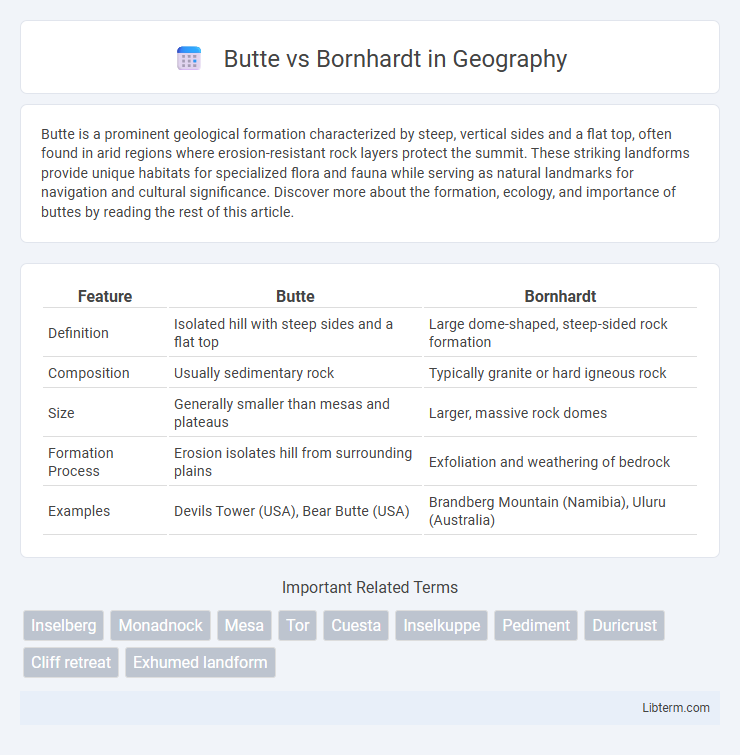Butte is a prominent geological formation characterized by steep, vertical sides and a flat top, often found in arid regions where erosion-resistant rock layers protect the summit. These striking landforms provide unique habitats for specialized flora and fauna while serving as natural landmarks for navigation and cultural significance. Discover more about the formation, ecology, and importance of buttes by reading the rest of this article.
Table of Comparison
| Feature | Butte | Bornhardt |
|---|---|---|
| Definition | Isolated hill with steep sides and a flat top | Large dome-shaped, steep-sided rock formation |
| Composition | Usually sedimentary rock | Typically granite or hard igneous rock |
| Size | Generally smaller than mesas and plateaus | Larger, massive rock domes |
| Formation Process | Erosion isolates hill from surrounding plains | Exfoliation and weathering of bedrock |
| Examples | Devils Tower (USA), Bear Butte (USA) | Brandberg Mountain (Namibia), Uluru (Australia) |
Introduction to Butte and Bornhardt
Buttes and bornhardts are prominent landforms characterized by isolated hills with steep, often vertical sides and flat or rounded tops. Buttes typically feature more distinct, flat summits formed through erosion of sedimentary rock layers, making them smaller and more angular than mesas. Bornhardts, composed mainly of hard, crystalline rock such as granite, exhibit smooth, dome-shaped profiles formed by deep weathering and exfoliation processes.
Geological Definitions: Butte vs Bornhardt
A butte is an isolated hill with steep, often vertical sides and a small, flat top, formed by erosion-resistant rock layers that cap softer rock. A bornhardt is a large, dome-shaped, steep-sided rock outcrop, typically composed of granitic or metamorphic rock, formed through exfoliation weathering and long-term erosion. While buttes are smaller and characterized by flat summits, bornhardts are massive, rounded features resulting from different geological processes.
Formation Processes of Buttes
Buttes form primarily through differential erosion, where harder rock layers resist weathering while softer surrounding materials erode over time, leading to isolated, steep-sided hills. These features often originate from sedimentary rock formations subjected to prolonged wind and water erosion in arid environments. In contrast, bornhardts develop through the weathering of massive, homogenous rock masses, such as granite, resulting in rounded domes rather than the sharp profiles typical of buttes.
Formation Processes of Bornhardts
Bornhardts form through deep chemical weathering that targets jointed rock masses, leading to the removal of surrounding weaker materials and leaving behind resistant, dome-shaped hills. Unlike buttes, which result from differential erosion of sedimentary layers with a flat top and steep sides, bornhardts develop primarily due to spheroidal weathering and exfoliation processes in granitic or massive rock types. The gradual exposure of bornhardts emerges from subterranean weathering, causing their characteristic smooth, rounded shape distinct from the angular profiles of buttes.
Key Differences in Appearance and Structure
A butte features steep, often vertical sides with a flat or slightly rounded top, forming as an isolated hill that is narrower than a mesa. In contrast, a bornhardt is a large, dome-shaped, smooth rock formation typically composed of granite or quartzite, with rounded edges and no flat summit. The key structural difference lies in a butte's sharp, cliff-like edges versus the bornhardt's broad, rounded surface shaped by weathering processes.
Geographic Distribution and Examples
Buttes are isolated hills with steep, often vertical sides and small, flat tops commonly found in arid regions such as the southwestern United States, including Monument Valley, Arizona. Bornhardts are large, dome-shaped, inselbergs composed of hard rock like granite, frequently occurring in tropical and subtropical regions such as the Sugarloaf Mountain in Brazil and Uluru in Australia. The geographic distribution of buttes centers on desert landscapes formed by erosion, while bornhardts appear in various climates due to their resistance to weathering processes.
Environmental and Climatic Influence
Buttes and bornhardts differ primarily in their formation due to environmental and climatic influences; buttes typically form in arid to semi-arid regions where wind erosion predominates, sculpting isolated, steep-sided hills from plateau remnants. Bornhardts develop in tropical or subtropical climates where chemical weathering, especially spheroidal weathering, breaks down surrounding rock, leaving dome-shaped inselbergs resistant to erosion. The climatic conditions dictate the dominant weathering processes, with dry climates favoring physical erosion for buttes and humid climates promoting chemical weathering that creates bornhardts.
Erosion Patterns in Buttes and Bornhardts
Buttes exhibit steep, isolated hills with flat tops formed primarily through differential erosion, where softer rock layers erode faster than resistant caprock, creating sharp, vertical cliffs. Bornhardts are large, dome-shaped granitic outcrops with gentle slopes resulting from exfoliation and gradual weathering processes that peel off outer rock layers, producing smooth, rounded surfaces. The key erosion pattern difference lies in buttes' aggressive vertical erosion creating pronounced cliffs, while bornhardts experience slow, uniform erosion yielding dome-like structures.
Significance in Geology and Geotourism
Buttes and bornhardts are significant geological landforms that provide insight into erosion processes and rock resistance, with buttes typically representing isolated hills with steep sides formed from sedimentary rock, while bornhardts are dome-shaped, inselberg structures composed mainly of hard, crystalline rocks like granite. Their prominence in geotourism lies in their striking visual appeal and ability to illustrate natural history, attracting researchers and tourists interested in geomorphology and landscape evolution. Understanding the formation and distribution of buttes and bornhardts aids in studying regional tectonics and climatic changes impacting weathering rates.
Summary: Choosing Between Butte and Bornhardt
A butte is a steep, isolated hill with a flat top and vertical or near-vertical sides, typically found in arid regions, formed by erosion of sedimentary rock layers. A bornhardt is a large, dome-shaped, inselberg composed primarily of resistant igneous or metamorphic rock, featuring smooth, rounded surfaces resulting from weathering. Selecting between a butte and a bornhardt depends on geological composition, formation processes, and landscape context, with buttes indicating sedimentary erosion and bornhardts signaling deep weathering of hard rock domes.
Butte Infographic

 libterm.com
libterm.com